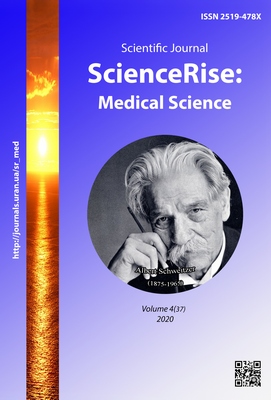Efficiency of double fixed combined therapy in patients with arterial hypertension and associated thyrotoxicosis after one year of treatment
DOI:
https://doi.org/10.15587/2519-4798.2020.209166Keywords:
cardiac remodeling, thyrotoxicosis, arterial hypertension, fixed combination antihypertensive therapy, ambulatory blood pressure monitoringAbstract
The aim: to evaluate the effectiveness of different fixed double antihypertensive combinations based on the results of outpatient monitoring of arterial pressure and to analyze their effect on central arterial pressure and cardiac remodeling in patients with arterial hypertension and thyrotoxicosis.
Materials and methods: patients with hypertension and TT who were included in the study were divided into groups using the blind envelope method with compensated TT: patients of group 1 were prescribed a fixed combination of perindopril with indapamide, group 2 - a combination of perindopril with amlodipine. Patients with uncompensated TT were prescribed a combination of bisoprolol with perindopril. The groups were statistically comparable in terms of age, duration of AH and TT, SBP and DBP levels. The observation of the patients lasted 12 months. After a year of follow-up, AMAD and EchoCG were performed in order to study AHT in patients with hypertension and TT. The patients were consulted by a cardiologist and endocrinologist.
Results: After 6 months of treatment, 8 (16 %) patients were excluded from the study, of which 6 (75 %) due to the need for surgical treatment and did not achieve euthyroidism, 2 (25 %) due to the need for antiarrhythmic therapy. Studied double fixed combinations effectively reduce blood pressure (BP) according to the results of ambulatory blood pressure monitoring (ABPM).
Conclusions: The fixed combination of perindopril with indapamide, perindopril with amlodipine, bisoprolol with perindopril provided a decrease in both blood pressure according to ABPM results and central pressure, however, this was not accompanied by a significant improvement in the structural and functional state of the heart
References
- Basnet, S., Dhital, R., Tharu, B., Ghimire, S., Poudel, D. R. (2018). Association between thyroid abnormalities and hypertension among hospitalized US patients: data from the National Inpatient Sample. Cardiovascular Endocrinology & Metabolism, 7 (4), 97–98. doi: http://doi.org/10.1097/xce.0000000000000155
- Yildiz, C., Altay, M., Yildiz, S., Çağir, Y., Akkan, T., Ünsal, Y. A., Beyan, E. (2019). Arterial stiffness in hyperthyroid patients is deteriorated due to thyroid hormones. Archives of Endocrinology and Metabolism, 63 (3), 258–264. doi: http://doi.org/10.20945/2359-3997000000135
- Amosova, K. М., Shyshkina, N. V., Rokyta, O. I., Rudenko, Yu. V., Katsytadze, I. Yu. (2016). Comparative evaluation of changes in brachial and central blood pressure in different categories of patients with uncomplicated arterial hypertension and determinants of pulse pressure amplification. Sertse i sudyny, 1, 37–45.
- Berta, E., Lengyel, I., Halmi, S., Zrínyi, M., Erdei, A., Harangi, M. et. al. (2019). Hypertension in Thyroid Disorders. Frontiers in Endocrinology, 10. doi: http://doi.org/10.3389/fendo.2019.00482
- Alekseeva, O. A., Shaposhnik, I. I., Bogdanov, D. V. (2019). Restoration of clinical and instrumental parameters of the cardiovascular system in patients with diffuse toxic goiter after resolution of thyrotoxicosis. Almanac of Clinical Medicine, 47 (2), 138–148. doi: http://doi.org/10.18786/2072-0505-2019-47-013
- Kniazkova, I. I., Zhadan, A. V., Nesen, A. O. (2017). Arterialna ryhidnist yak chynnyk ryzyku i likuvalna mishen pry arterialnii hipertenzii. Praktychna anhiolohiia. 1 (76), 5–14.
- Tsymbaliuk, I. L. (2016). Optymizatsiia likuvannia ta profilaktyky sertsevo-sudynnykh porushen u khvorykh na arterialnu hipertenziiu, poiednanu z tyreotoksykozom. Zaporizhzhia.
- Williams, B., Mancia, G., Spiering, W., Agabiti Rosei, E., Azizi, M., Burnier, M. et. al. (2018). 2018 Practice guidelines for the management of arterial hypertension of the European Society of Cardiology and the European Society of Hypertension. Blood Pressure, 27 (6), 314–340. doi: http://doi.org/10.1080/08037051.2018.1527177
- Ross, D. S., Burch, H. B., Cooper, D. S., Greenlee, M. C., Laurberg, P., Maia, A. L. et. al. (2016). 2016 American Thyroid Association Guidelines for Diagnosis and Management of Hyperthyroidism and Other Causes of Thyrotoxicosis. Thyroid, 26 (10), 1343–1421. doi: http://doi.org/10.1089/thy.2016.0229
- Marwick, T. H., Gillebert, T. C., Aurigemma, G., Chirinos, J., Derumeaux, G. (2017). Recommendations on the use of echocardiography in adult hypertension: a report from the European Association of Cardiovascular Imaging (EACVI) and the American Society of Echocardiography (ASE). Systemic Hypertension, 14 (2), 6–28. doi: http://doi.org/10.26442/2075-082x_14.2.6-28
- Babenko, A. Yu. (2014). Cardiovascular disorders in thyrotoxicosis of various origins: optimization of treatment approaches. Mezhdunarodnii endokrinologicheskii zhurnal, 8 (64), 65–78.
- Hegedus, L. (2018). Does therapy for thyroid dysfunction decrease mortality? Endocrine Abstracts. Barcelona. doi: http://doi.org/10.1530/endoabs.56.pl6
- Lillevang-Johansen, M., Abrahamsen, B., Jørgensen, H. L., Brix, T. H., Hegedüs, L. (2019). Duration of Hyperthyroidism and Lack of Sufficient Treatment Are Associated with Increased Cardiovascular Risk. Thyroid, 29 (3), 332–340. doi: http://doi.org/10.1089/thy.2018.0320
- Cherenko, M. S. (2016). The current opinion on management and treatment of hyperthyroidism and other forms of thyrotoxicosis: review of the latest Guidelines of American Thyroid Association (2016). Clinical Endocrinology and Endocrine Surgery, 4 (56), 87–94. doi: http://doi.org/10.24026/1818-1384.4(56).2016.87324
Downloads
Published
How to Cite
Issue
Section
License
Copyright (c) 2020 Vira Tseluyko, Daria Korchagina

This work is licensed under a Creative Commons Attribution 4.0 International License.
Our journal abides by the Creative Commons CC BY copyright rights and permissions for open access journals.
Authors, who are published in this journal, agree to the following conditions:
1. The authors reserve the right to authorship of the work and pass the first publication right of this work to the journal under the terms of a Creative Commons CC BY, which allows others to freely distribute the published research with the obligatory reference to the authors of the original work and the first publication of the work in this journal.
2. The authors have the right to conclude separate supplement agreements that relate to non-exclusive work distribution in the form in which it has been published by the journal (for example, to upload the work to the online storage of the journal or publish it as part of a monograph), provided that the reference to the first publication of the work in this journal is included.









